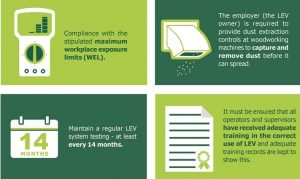Local exhaust ventilation is an extract ventilation system that takes airborne contaminants such as dusts, mists, gases, vapour or fumes out of the workplace air so they cannot be breathed in.
Properly designed LEV will:
– collect the air that contains the contaminants
– make sure they are contained and taken away from people
– clean the air (if necessary) and get rid of the contaminants safely
Substances that have been classified as being ‘very toxic’, ‘toxic harmful corrosive’ or ‘irritant’, such as wood dust, is given a Workplace Exposure Limit (WEL) under the Control of Substances Hazardous to Health (COSHH) regulations. A WEL will determine the legal limits of exposure, averaged over a specified timeframe, a worker can be exposed to that substance. There are various types of materials used within the woodworking industry, which are hazardous by inhalation, ingestion (swallowing) and absorption (through the skin) which are regulated by COSHH, including hardwood and softwood dust that have WEL’s that should not be exceeded.
Exposure to harmful contaminants such as dust can show immediate results including dermatitis (skin rashes) breathlessness and burns. There are also long-term effects, such as allergic asthma or allergic dermatitis, which not only prevent a worker from continuing in his occupation but could also lead to death.
Under the COSHH Regulations it is a legal requirement for a woodworking workshop / manufacturing site to have a LEV system installed to reduce employee exposure to airborne contaminants that might be hazardous to health. The Regulations also require those responsible for any wood dust extraction equipment to make a written assessment of the risks to health associated with wood dust, together with any action needed to prevent or control those risks.
• Dust extraction (LEV) for woodworking machines must capture and remove dust before it can be spread. The current Workplace Exposure Limit (WEL) is 3mg/m3 for hardwood and 5mg/m3 for softwood.
• LEV must have a Thorough Examination and Test to Regulation 9 of COSHH carried out by a competent person at least every 14 months. A competent person should have the right mix of skills, knowledge and experience to carry out the examination and test. Staff should also be trained on how to maintain the LEV.
• To ensure LEVs continue to work properly, a log book should be kept that includes schedules of regular checks and maintenance.
Wood Dust under the Health & Safety Executive:
HSE’s inspectors across Great Britain will be targeting construction firms to check that their health standards are up to scratch.This year inspections will focus on respiratory risks and occupational lung disease, looking at the control measures businesses have in place to protect their workers’ lungs from construction dust including silica, asbestos and wood dust. This is part of HSE’s longer term health and work strategy to improve health within the construction industry.
While the primary focus will be on health during this programme of inspections, if an inspector identifies any other areas of concern, including immediate safety risks, they will take the necessary action to deal with them.
Inspectors will be looking for evidence of employers and workers knowing the risks, planning their work and using the right controls. If necessary, they will use enforcement to make sure people are protected.
For more information on the programme of inspections visit the Work Right campaign website: https://workright.campaign.gov.uk/campaigns/construction-dust/
The Health & Safety Executive also offers a course on LEV – “Practical Management of Local Exhaust Ventilation Controls”. to find out more, click here.
